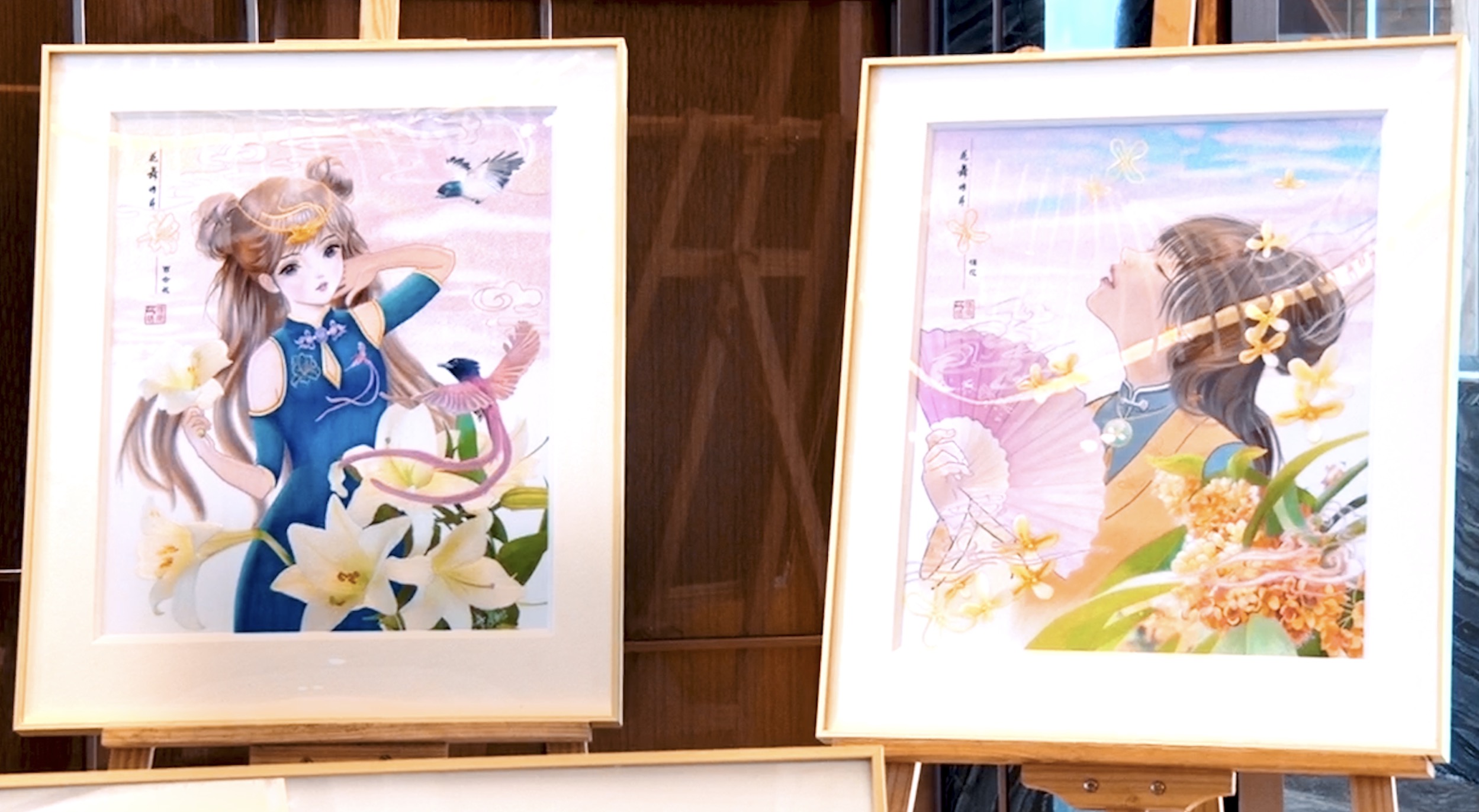
Qixi, known as the "Chinese Valentine's Day," stands as one of the nation's most romantically tinted traditional festivals. The tale of the Cowherd and the Weaver Girl reflects the timeless love story of the Chinese people. Across the Milky Way, one side gleams with the Cowherd Star (star of Altair), while the other sparkles with theWeaver Girl Star (star of Vega). In ancient China, these stars were used as navigational guides. Over time, the relationship between them evolved into a couple, enriching the story of their annual meeting on the Magpie Bridge across the Milky Way on the seventh day of the seventh lunar month. This gradually turned Qixi into China's equivalent of Valentine's Day.

But Qixi is not just about love. It's also known as "Qi Qiao Jie" or the "Begging for Skills Festival." On this day, one common tradition involves young girls presenting seasonal fruits to the moon at night, praying for dexterity and a fortunate encounter in love.
In anticipation of this year's Qixi, Tan Zhanpeng, a provincial-level representative inheritor of Canton Embroidery, has unveiled a new masterpiece titled "Threading a Needle Under the Moon." This artwork breaks from traditional styles and features an anime-inspired portrayal of a young girl skillfully threading a needle under the moonlight. Adorned in a blue gown with a phoenix-shaped hairpin, the girl is set against a particularly radiant first quarter moon.
Tan Zhanpeng's journey into the world of art began at an early age, as he learned painting and Canton Embroidery techniques from his mother, Chen Shaofang, a Chinese Master of Arts and Crafts and a national-level representative inheritor of Canton Embroidery. Before fully dedicating himself to the world of embroidery, Tan worked in maritime affairs, but his creative spirit never wavered. Tan fondly recalls how his piece "Realization of Grand Ambitions," depicting a majestic eagle soaring against the sunlight over the sea, was inspired by sketching aboard a ship. In 2000, driven by his mother's aging health, Tan left his job and, alongside his wife Huang Minjian, wholeheartedly embraced the mission of preserving and promoting Canton Embroidery. Today, Tan's studio occupies a modest second-floor space in an unassuming brick-red building in Fang Village. The rent is affordable, and the locale attracts a wealth of arts and crafts resources. This unassuming space has borne witness to Tan's emotional investment and innovative spirit in advancing the cause of Canton Embroidery.

Tan Zhanpeng sees himself as a designer. As a representative inheritor, he believes that heritage extends beyond mastering techniques; it involves designing to effectively showcase the beauty of Canton Embroidery and embracing the market. Over the years, he has been actively exploring ways to integrate Canton Embroidery into contemporary life, infusing his creations into clothing design.
In terms of subject matter, Tan Zhanpeng is in pursuit of innovation. His latest work, "Threading a Needle Under the Moon," is themed around the traditional festival of Qixi. He believes that for Canton Embroidery to find its place in various aspects of modern life, it must captivate the younger generation's attention.

Tan Zhanpeng asserts that to restore Canton Embroidery's former glory, it must be regarded as a component of the societal supply chain. "This requires inheritors to shift their mindset, embrace industrial technology, and accept mechanized mass production, allowing Canton Embroidery to once again be a part of the societal supply chain." Tan is confident in this approach, believing that with persistence and government support, the renaissance of Canton Embroidery is inevitable.
视频|谭展鹏:要让广绣再次成为“潮品”
七夕”是中国最具浪漫色彩的传统节日之一。牛郎织女情,折射着中华民族穿越时空的婚恋观。银河两岸,一边是牵牛星,一边是织女星。在中国古代,先民们长期把它们作为指向方位的星宿。后来,牛郎和织女之间逐渐被想象成情侣的关系、夫妻的关系,七月七牛郎织女星渡银河踏鹊桥相会的故事就丰富起来了。于是,七夕节逐渐被视为中国的情人节。
实际上,与“七夕”相关的不只是爱情。它又称“乞巧节”,这一天,民间最常见的习俗就是女孩们在晚上对着明月摆上时令瓜果,诚心拜祭,祈求心灵手巧,同时早遇良缘。
今年“七夕”前夕,广绣省级代表性传承人谭展鹏特别设计了一幅新作《月下穿针》,吸引了人们的关注。该作品一改传统广绣特色,以动漫画风展现出一名少女对着明月穿针乞巧的画面。少女身着一袭蓝衣,头戴凤形发簪,她的前方,一轮上弦月分外明亮。
谭展鹏从小就随他的母亲——中国工艺美术大师、广绣国家级代表性传承人陈少芳学习绘画和广绣技艺,但在专注于广绣事业之前,他原本在航道局工作,但也从未停止创作。谭展鹏回忆,他的作品《鸿图大展》中表现的一只在海上迎着阳光展翅的大鹏,灵感就来自当时在船上的写生。2000年,因母亲年事渐高,谭展鹏毅然辞去工作,与妻子黄敏健一起全身心投入到广绣传承中。如今,谭展鹏将工作室落址于芳村一座不起眼的砖红色楼房二层,这里租金便宜,但工艺美术资源聚集。这间工作室见证了谭展鹏为广绣事业投入的情感与创新。
谭展鹏对自己的定位其实是设计师。作为传承人,他认为传承的概念不仅是学会技法,还要通过设计,更好地展现广绣之美,更好地拥抱市场。这些年来,他一直在探索如何使广绣与当代生活产生连接,积极地在服装设计中融入广绣创作。
在题材方面,谭展鹏也在寻求突破。这次“七夕”之际,他绣制的《月下穿针》就是根据传统节庆创作的应景作品。他认为,广绣要吸引年轻人的目光,未来才有机会运用到更多生活场景中去。
谭展鹏认为,当下想要重铸广绣辉煌,就必须将非遗手工艺视为社会供应链中的一环。“这需要传承人转变观念,拥抱工业技术,接受机械化大批量生产,让广绣回到社会供应链中去。”谭展鹏对此是有信心的,他认为只要坚持做下去,再加之政策扶持,统筹协调,广绣的春天一定会再度来临。
出品人|杜传贵 林海利
策划|孙爱群 陈桥生
监制|邓琼 蒋铮 吴小攀
统筹|朱绍杰 何奔 付怡
执行|周欣怡 彭灏明 文艺 黄宙辉 孙磊
文|羊城晚报全媒体记者 周欣怡 朱绍杰
图、视频|彭灏明 戚容源 彭泽祥 唐德荣 林丹丹 吴垂瑾 (实习) 张嘉浩 (实习)
翻译|刘佳慧
责编 | 王楠
校对 | 周勇
-
Data|Guangdong's economy maintains recovery from Jan. to July
2023-08-23 23:13:43 -
Video | Tan Zhanpeng: Reviving Canton Embroidery as a trendy art
2023-08-23 17:51:30 -
Y Talk㉖| Why is BRICS so attractive? 金砖集团狂“吸粉”,魅力从何而来?
2023-08-23 17:17:04 -
Exclusive | Xie Xiaoyong: China-Europe Railway Express injects a "reassurance" for expanding bilateral trade between China and Belarus
2023-08-23 14:47:24






